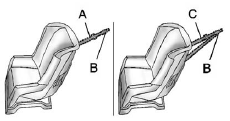 GMC Terrain: Top Tether Anchor
GMC Terrain: Top Tether Anchor

A top tether (A, C) anchors the top of the child restraint to the vehicle. A top tether anchor is built into the vehicle. The top tether attachment (B) on the child restraint connects to the top tether anchor in the vehicle in order to reduce the forward movement and rotation of the child restraint during driving or in a crash.
Your child restraint may have a single tether (A) or a dual tether (C). Either will have a single attachment (B) to secure the top tether to the anchor.
Some child restraints that have a top tether are designed for use with or without the top tether being attached. Others require the top tether always to be attached. In Canada, the law requires that forward-facing child restraints have a top tether, and that the tether be attached. Be sure to read and follow the instructions for your child restraint.
 Lower Anchors
Lower Anchors
Lower anchors (A) are metal bars built into the vehicle. There are two lower
anchors for each LATCH seating position that will accommodate a child restraint
with lower attachments (B). ...
 Lower Anchor and Top Tether Anchor Locations
Lower Anchor and Top Tether Anchor Locations
Rear Seat
(Top Tether Anchor): Seating positions
with top tether anchors.
(Lower Anchor): Seating positions
with two lower anchors.
The rear outboard seating positions have exposed metal anch ...
See also:
Automatic deactivation
Cruise control is automatically deactivated
temporarily if one of the following occurs:
• If the speed drops below approximately
20 mph (30 km/h).
• When the brake pedal is depressed.
• I ...
Compact Spare Tire
WARNING
Driving with more than one compact spare tire at a time could result in loss
of braking and handling. This could lead to a crash and you or others could be injured.
Use only one compact s ...
Checking the tire pressure
1. Remove the valve stem cap from the
tire.
2. Press the pressure gauge squarely onto
the valve stem. Do not press too hard or
force the valve stem sideways, or air will
escape. If the hiss ...
